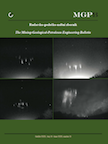Mapping and modelling fractures using ground penetrating radar for ornamental stone assessment and recovery optimization: Two case studies
DOI:
https://doi.org/10.17794/rgn.2017.4.7Abstract
Rock mass is typically characterized by inherent fractures that cause natural blocks of rocks. Unplanned cutting of stone deposits in quarries may lead to over-producing waste (rock debris) or extracting unfi t (fractured) stone blocks. This paper presents two case studies through the use of low and high frequency Ground Penetrating Radar (GPR) antennas to detect fractures in two benches of a quarry. In the fi rst case study, a high frequency GPR antenna was used aiming to: (i) compare the GPR results with a map of the out-cropping fracture intensity in the bench surface, developed using the data of the GPR survey marks and interpolated by the Ordinary Kriging technique, and (ii) present how sub-vertical fractures can be numerically modelled in three dimensions from the GPR results. The second case study was focused on using a low frequency antenna to detect large aperture size of fracture surfaces as deep as possible in order to evaluate a deposit stratum before quarrying. This could be done through studying the refl ections from a 3D cross-sectional GPR model and
a 3D transparent GPR model. In the discussion section, an exploitation planning approach, based on modelling fractures as 3D surfaces, is theoretically and graphically proposed to optimize the stone production recovery. The two case studies showed that GPR is a successful tool for the assessment of ornamental stone deposits and a promising tool for recovery optimization.
Downloads
Published
How to Cite
Issue
Section
License
Copyright (c) 2017 Rudarsko-geološko-naftni zbornik

This work is licensed under a Creative Commons Attribution 4.0 International License.
Creative Commons-BY
Authors who publish with this journal agree to the following terms:
In agreeing this form, you certify that:
- You read the ethical codex of the RGN zbornik available at journal web.
- You submitted work is your original work, and has not previously been published and does not include any form of plagiarism.
- You own copyright in the submitted work, and are therefore permitted to assign the licence to publish to RGN zbornik.
- Your submitted work contains no violation of any existing copyright or other third party right or any material of an obscene, libellous or otherwise unlawful nature.
- You have obtained permission for and acknowledged the source of any illustrations, diagrams or other material included in the work of which you are not the copyright owner.
- You have taken due care to ensure the accuracy of the work, and that, to the best of your knowledge, there are no false statements made within it.
- All co-authors of this submitted work are aware of, and in agreement with, the terms of this licence and that the submitted manuscript has been approved by these authors.
Publication licence
You retain copyright in your submitted work, according to journal license policy (CC-BY). By signing this form you agree that RGN zbornik may publish it under the publication licence. In summary the licence allows the following:
Anyone is free:
- To copy, distribute, display, and perform the work.
- To make derivative works.
Under the following conditions:
- The original author must always be given credit.
- The work may not be used for commercial purposes.
- If the work is altered, transformed, or built upon, the resulting work may only be distributed under a licence identical to this one.
Exceptions to the licence
In addition to publishing the work printed under the above licence, RGN zbornik will also enable the work to be visible online.
The journal editorial can change the licence rules anytime but it cannot retroactively restrict author(s) rights.


